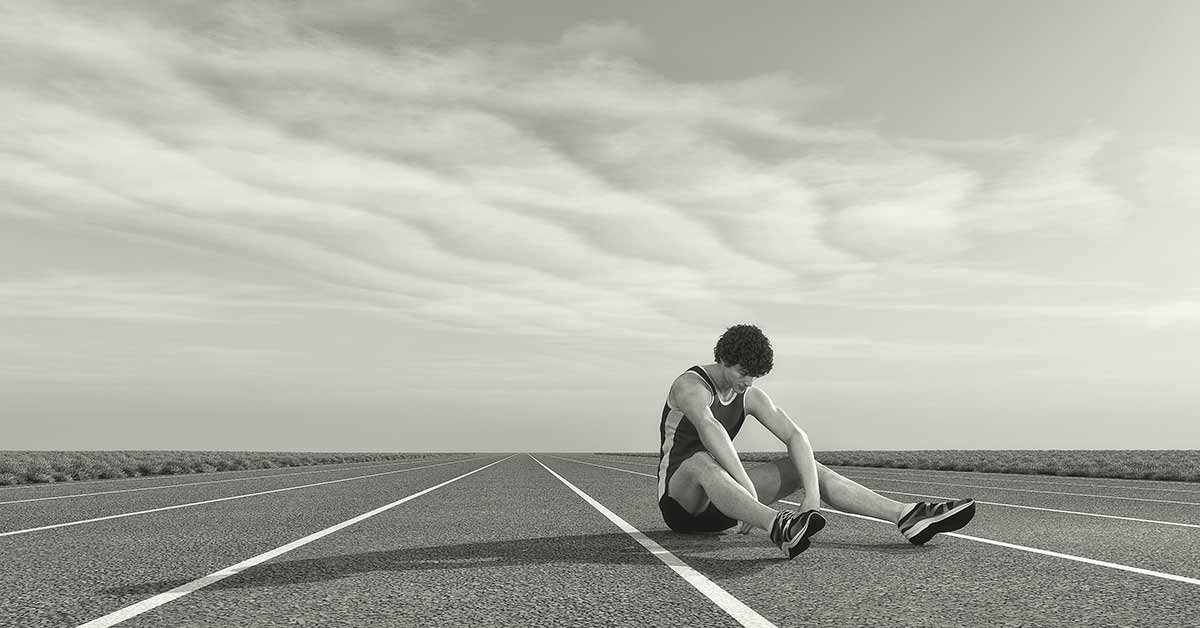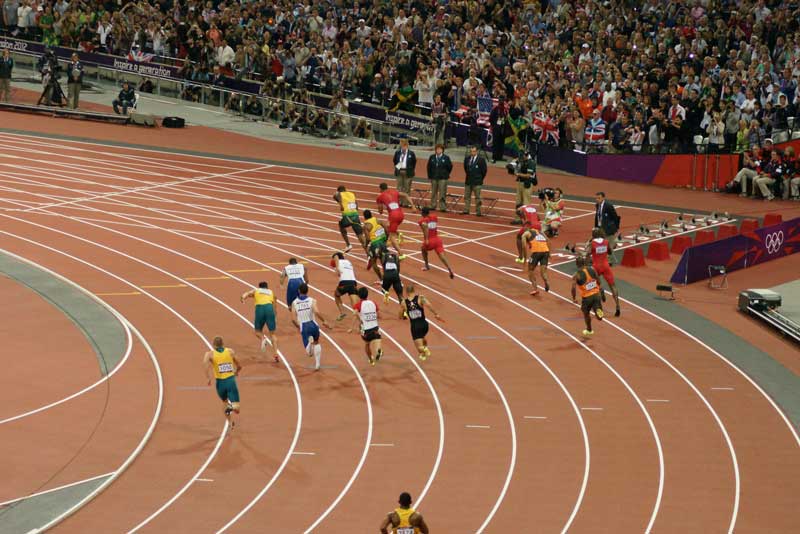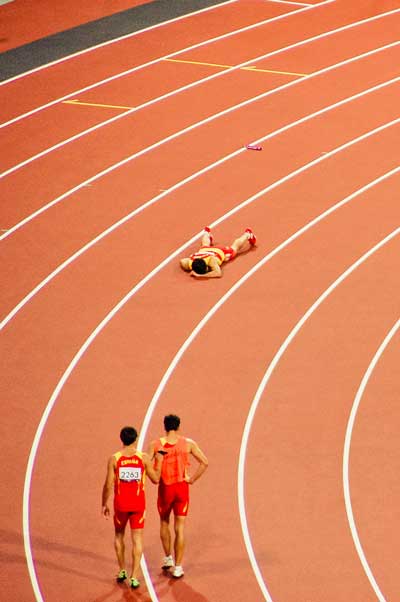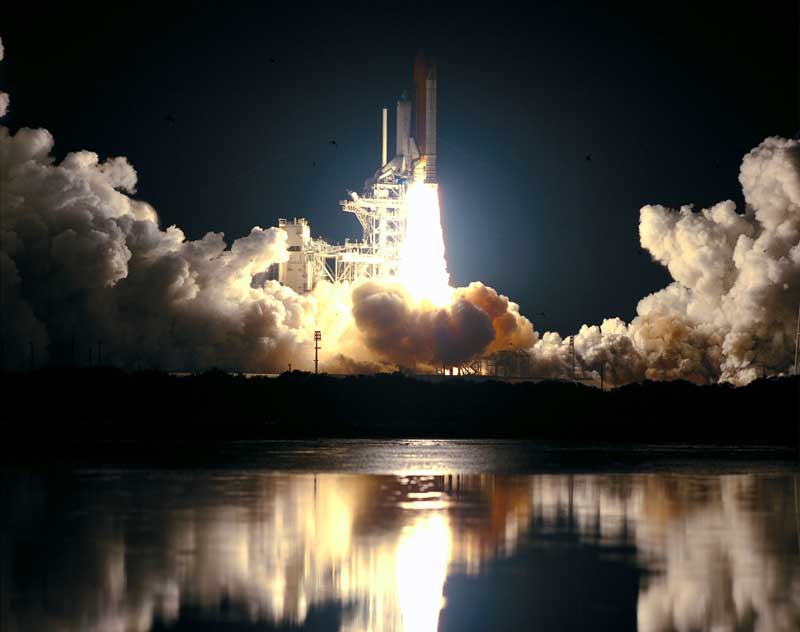

21st August 2008. 8.20pm.
I am standing in the Bird’s Nest Stadium in Beijing, watching the first heat of the men’s 4 x 100 metre relay take place. I’ve been waiting for this moment for years: my chance to win an Olympic medal. By my reckoning, we have an incredibly good chance of getting the bronze. We are reigning Olympic champions, and the prior year, I was part of the team that won the bronze at the World Championships in Osaka. Jamaica was clearly going to win—any team that could field the new superstar of the sport, Usain Bolt, was going to be a clear favourite. The USA would also be tough to beat, but outside of that, I really fancied our chances.
I’m running 4th leg, which means I stand by the 100 m start, watching this heat. The gun goes, and it’s a pretty standard race. The USA and Trinidad & Tobago are locked in an interesting race, but the US has Tyson Gay on anchor, so I expect the team to pull clear. Something goes wrong (I can’t tell what), but there’s a baton on the floor, and Gay stops running. The US is out. This is good news for us.

I step out onto the track and measure out my check mark; once the incoming runner gets to this point, I have to start running. It’s an exact science, something we practiced in training. If I leave too early, the incoming athlete will struggle to catch me. If I leave too late, he will catch me too early, and our baton speed will drop. After I’ve measured the distance, I check and then recheck to make sure it’s in the right place. It is.
We take off our kit. My heart is beating, and I’m nervous. I’ve only run this leg once in the previous six years. Asafa Powell is in the lane next to mine. If I don’t run well, I’m going to look stupid. I’ll also probably get replaced for the final.
The gun goes. I can see our first leg runner, Simeon Williamson, run a good leg, and pass the baton to Tyrone Edgar on the second leg. It’s a good change, and we are there or thereabouts with Jamaica. About halfway through Tyrone’s leg, I glance down, checking my feet are in the right position. I look back; it’s a good change from Tyrone to Marlon Devonish, running third leg for us. I look away again and crouch down into my three-point stance. I check back and take my set position; Marlon is almost halfway round the bend. I watch him get closer and closer to the check mark, watching each step get closer and closer to the bit of white tape on the floor. Then I go.
I know straight away something is wrong. In the heat of the moment, my brain can’t decide what, but it doesn’t feel right. Playing it back in my head now, what I think I was aware of was a complete silence; I couldn’t hear anyone running. This is a bad sign; it means I’ve left early. Sensing something is wrong, I start to slow down. I see the midway point of the changeover box approaching, and I still can’t hear Marlon. I slow down some more and put my hand back to give him a target. My eyes are now locked on the end of the changeover box. Each stride I take is about two metres long, and in four steps, I will be outside the box. I’m slowing down as much as I can. The line is getting closer and closer. I’m trying to keep my hand still so Marlon has a good target to hit. I cross the end of the changeover box, and at the same time, the baton hits my hand. There’s a photo of this exact moment, and if you look at my face, you can tell I know. My eyes are closed, and I’m grimacing. I know this hasn’t gone well. I take the baton and chase after Asafa Powell, who, by now, is ten metres ahead of me. We cross the line second, in an automatic qualifying place. I feel numb. I know I’m responsible for a mistake, but I’m clinging to the hope that maybe, just maybe, I was inside the box.
Mistakes Worth Making

Those of you who know my story know that, of course, I wasn’t inside the box. We were disqualified, and as a result, my dream of an Olympic medal perished. Not only that, the dreams of my teammates, coaches, and support staff had perished as well. Worst of all, I was responsible for everything. I had made a huge error that cost me and my team a piece of history.
Let’s start at the beginning: what went wrong? I have never watched the footage of that day, as the memory is still far too painful. From a conversation with our biomechanist, who was filming the race for analysis, I learned I left about three metres early. This was absolutely criminal on my part; it’s a mistake that you cannot recover from. No one wants to make a mistake. I didn’t go into that race hoping or planning to leave early. I just wanted to do my best. Nevertheless, mistakes do happen, and since that race, the Great Britain relay team has been disqualified at four of the six major championships it has competed in. These weren’t deliberate acts by any of the athletes involved. Nevertheless, mistakes happen, and the first step towards recovery is to understand why.
I’ve obviously had a lot of time to think about why this mistake happened, especially in the days immediately after the race. I’ll precede my explanation of events by pointing out that I accept full responsibility for what happened—had I not left early, we wouldn’t have been disqualified. Why did I leave early? If I go back and look at the data from our pre-Olympic training camp, I can see that it was a disaster waiting to happen. In about 50% of all the changeovers in which I was an outgoing runner, I left early. On two occasions, I left two metres early. However, none of these changeovers were incomplete, and this led to a false sense of security. As a consequence, there was no pressure on me, either internally or from coaches, to rectify this problem. An additional factor is that it was only the second time in my professional athletics career that I had run fourth leg. This disrupted my whole process; running second leg (my usual and preferred leg), I would go into my three-point stance when the starter said “On Your Marks.” I would go into my set position when the gun went. I would follow the incoming runner all the way round the bend. I had built this process up over many low-profile, low-pressure relay races. Compare this to Beijing, where I had no ingrained process, no mental checklist to run through once I got onto the track to race. I had to learn during the most high pressure event of my career. Both of these issues, I feel, contribute to and potentially caused the mistake to occur.
Once a mistake has happened, it’s important to react to it positively. I was determined to learn from what happened, to prevent it happening in the future. Every relay training session after Beijing, I asked for and received immediate feedback on whether or not I left early or late. I was hard on myself to ensure that I left exactly on the check mark. The result of this was that I didn’t leave early in a relay race ever again; in fact, I left spot on the checkmark in both relay races at the 2011 World Championships in Daegu. Learning from your mistakes is a crucial aspect of bouncing back from them. Psychological recovery from errors is also important. Making a high profile mistake can eat away at you for months, even years. It’s a stressful experience, but I was determined to bounce back from it. The first step was to put it in perspective. Yes, I had messed up at the biggest competition of my life, but I was still alive. I still had things to look forward to. In the larger scheme of things, it didn’t matter. People would soon forget about it.
I’m a big believer that mistakes are an important part of the learning process. As I discussed earlier, I learned the importance of leaving at exactly the right time, and it contributed to my being a better relay athlete. I also learned valuable lessons about how to prevent future mistakes, something that I bring into my coaching now. Mistakes are important because they enable us to refine our process. It’s impossible to predict every eventuality, and so when things go wrong, you learn what you need to focus your energy on. Disastrous mistakes are also often a symptom of an underlying issue. For me, the underlying issue was leaving early in training. Competition just magnifies the errors you make, due in part to the large increases in adrenaline. Another issue is that the fear of mistakes is stifling. We need to have a culture where they are allowed to happen, so long as they are learned from with an end goal in mind. If an athlete goes into competition with the fear of making an error, then he or she is going to be mentally pre-occupied with not making it, and thus, under-perform. Going into the 2011 World Championships 4 x 100 metre final, I could have chosen to pre-occupy myself with not leaving early. This would have taken up mental capacity and caused me to second guess myself, in which case I would have left late. This is almost as bad as leaving early. Instead, it’s much better to focus on eliminating the mistake in practice so that competition is automatic. I knew that I wasn’t going to leave early, as I worked hard on it in training and low-pressure competitions, so I trusted my process. Correct, error-free training results in a correct, error free competition.
Fatal Errors

Whilst my mistake was painful and tough to accept, nobody died, and it only affected a few other people. This isn’t always the case. If we look at the 2003 Columbia Space Shuttle disaster, we can see examples of what I have already discussed. During the launch, a big bit of foam broke off from the main rocket, striking the space shuttle. This impact damaged The shuttle’s heat shield. As a result of this, the shuttle was not adequately protected from high temperatures, and upon re-entry to the Earth’s atmosphere it overheated and disintegrated. Amazingly, this wasn’t the first time that foam had dislodged during launch and struck the space shuttle. On at least four prior flights, NASA had footage of the same thing happening. However, because there had been no serious consequences from this, the management at NASA became accustomed to this happening. Instead of trying to fix a potentially deadly problem, the lack of serious consequence created a process error that lead to a major disaster. This mirrors (although at a much higher profile level) the mistakes that I was making in training prior to the Olympic Games.
Like me, NASA learned from the Columbia disaster. They implemented on-orbit inspections of the heat shield after each launch, so that any damage could be detected and dealt with. For subsequent shuttle launches, there was a designated rescue mission setup – an additional shuttle could be launched to rescue the astronauts, or they could dock with the International Space Station. NASA learned similar lessons in the wake of the Challenger disaster in 1986.
Conclusion
To conclude, I believe that mistakes are a symptom of an underlying cause. By correcting mistakes in training, the chances of them occurring in competition are lowered. However, mistakes can and do happen. When one occurs, it is crucial that lessons are learned from it, and these lessons are implemented to prevent future errors. Mistakes can also be useful in illustrating where part of the process is going wrong and needs to be corrected; lack of a negative outcome from an error does not mean that it should be ignored! Finally, we, as coaches, should promote a culture where the fear of mistakes is not prevalent and make sure our athletes are encouraged to learn from any that they do make and implement these learning processes to improve their future performance.
Further Reading
How Can We Learn From Fatal Mistakes In Surgery?
TED Talk – How To Learn From Mistakes
Article on Organisational Culture and Mistakes in NASA Leading Up To Columbia Disaster
Since you’re here…
…we have a small favor to ask. More people are reading SimpliFaster than ever, and each week we bring you compelling content from coaches, sport scientists, and physiotherapists who are devoted to building better athletes. Please take a moment to share the articles on social media, engage the authors with questions and comments below, and link to articles when appropriate if you have a blog or participate on forums of related topics. — SF


An Harvard sports psychologist once told me human’s are perfect mistake making machines, And when mistakes occurs learn the good and the bad from them.